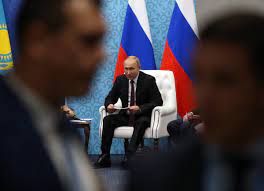Alexey Gorbachev
From headlines taken out of context to the framing of fringe figures as representative of wider American views, Russian state-run outlets are cherry-picking US content to back up Kremlin narratives. And it comes with results. Headlines such as “Biden accused of concealing extent of corruption in Ukraine” and “US highlights NATO inability to withstand Russia for extended period” regularly propel state-run stories into the top five spots on Russian search engines, with a potential reach of millions of views.
Americans regularly cited by Russian media include former Fox News commentator Tucker Carlson, Republican Representative James Comer, and members of “The Squad,” a group of Democrats who push more leftist ideals in Congress. Extremes of the political spectrum are wrapped into Russian disinformation efforts to both amplify issues and lend an air of legitimacy to anti-Western and anti-Ukrainian narratives, said Nina Jankowicz, vice president of the Centre for Information Resilience and a former disinformation chief under the Biden administration.
“We see Russia identifying individuals on the left or right of the political spectrum who might already be critics of NATO, critics of Ukraine,” Jankowicz told VOA. That strategy is employed by Vladimir Soloviev, a Russian TV presenter whose Telegram channel has more than a million subscribers. Soloviev gained notoriety by advocating for the invasion of Ukraine, actively supporting President Vladimir Putin and promoting the idea of nuclear warfare against the West.
To reinforce those views, he regularly references Carlson. A search by VOA for Carlson references on the Telegram account between June 2020 and November 2023 returned more than 230 instances. The number of references spiked following the full-scale invasion. The key narratives of Carlson selected by Soloviev and Russian propaganda channels include the conservative pundit’s false claims that Christians in Ukraine are persecuted, that America’s white population is oppressed and Tucker’s characterization of some US media coverage of Ukraine as lies.
Other outlets take fringe commentators most Americans are unlikely to have heard and present them as having a wider influence. These are often used to reinforce Russia’s narrative of a “declining” West, with state-run media citing figures such as Jackson Hinkle and Jack Posobiec, who are largely unknown in the United States but are favored among the far right and in conspiracy circles on X, formerly Twitter. RIA Novosti, for instance, highlighted Posobiec’s mocking comment about Kyiv’s interest in Abrams tanks, presenting it as a view from a respected veteran and combining it with a quote from Putin emphasizing Moscow’s purported aim to end, not escalate, the conflict.
Similarly, Russian news outlet Lenta.Ru used a headline quoting Hinkle’s suggestion that the Ukrainian Armed Forces’ counteroffensive be labeled as a suicide mission. And Soloviev frequently references both Americans in his Telegram channel, portraying them as influential bloggers, talk show hosts, or renowned US journalists.
The approach helps Russia create the appearance of more significant support for opinions that – according to analysts who spoke with VOA – are better characterized as fringe views. And it can lead regular Russians to believe the views are more representative of how most Americans think, Jankowicz said. Outlets such as Breitbart and Fox News on the right and The Grayzone on the left are also used by Russian state media, with stories circulating between the Russian and US organizations, she said.
Jankowicz said that while she was in her role on the US Disinformation Governance Board, American right-wing media outlets falsely characterized the board’s role as being to censor Americans. “This was absolutely not true, and within a couple of days after that, we saw [the same report] on Russian Channel One with the same quotes, the same pictures, the same narratives overarching,” Jankowicz said. The disinformation governance board – formed by the US Homeland Security Department to counter misinformation – was disbanded after only a few weeks.
Featuring statements from American figures and media outlets lends a sense of credibility, she said. “Showing these extreme viewpoints also hammers home the ideas about Ukraine or about US foreign policy that the Kremlin wants its audiences to believe,” Jankowicz said. Dominik Stecula, an assistant professor of political science at Colorado State University who focuses on political polarization, has seen similar trends. Stecula said the commentator Carlson has repeated Russian propaganda narratives on his TV show. But Carlson’s departure from Fox in April, along with a shift in media attention to other news stories such as the Israeli-Hamas conflict, slightly changed the US media landscape on the right, Stecula said. “Whoever is filling in his shoes hasn’t really spent as much time on this topic at all. The general focus on Ukraine dissipated.”
Another aspect that unites some far-left and far-right political actors is populism, Stecula said. “They were repeating some of the Russian propaganda about Ukraine, about politicians in Ukraine, like President [Volodymyr] Zelenskyy.” The academic said that far-right actors in the US root their narratives primarily in the idea of America-first nationalism, while those on the far left see it “through the lens of American imperialism wielded through the power of NATO.” Overall, Carlson, Elon Musk and niche bloggers such as Hinkle and Posobiec have significant influence within their respective ideological echo chambers, Stecula said.
At the same time, members of “The Squad” – US Congresswomen Alexandria Ocasio-Cortez, Ilhan Omar, Ayanna Pressley and Rashida Tlaib – have substantial influence within the Democratic Party, while not wholly representing the party’s mainstream, Stecula said. “They’re not just your average social media influencer,” Stecula said. “These are people with significant platforms and actual positions of power. Which is why it was disappointing to see some of their behavior during the initial months of the Russian invasion and Ukraine, when they were taking stands aligned with some of right-wing Republicans.” What the Russian invasion of Ukraine really highlighted, the academic noted, is that populism and a rejection of the mainstream have significantly united those on America’s far left and far right.
Jankowicz said that while a certain percentage of Americans may share the views of some of these people, the reality is that opinion is far more varied. “And so, I think showing these extreme viewpoints also hammers home the ideas about Ukraine or about US foreign policy that the Kremlin wants its audiences to believe,” she said.
VOA







